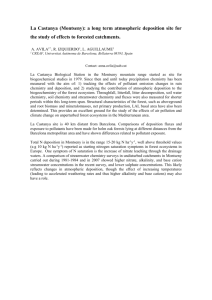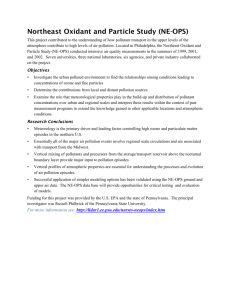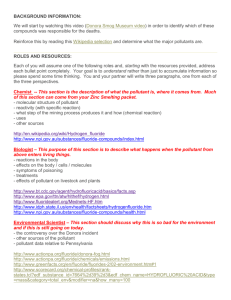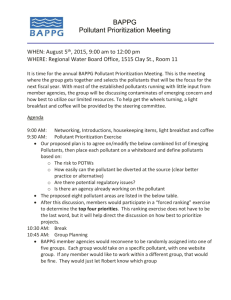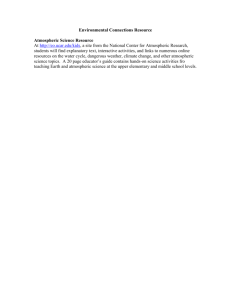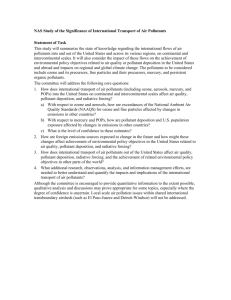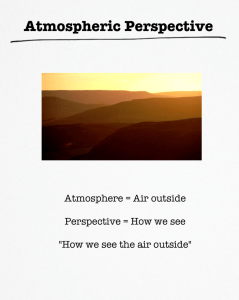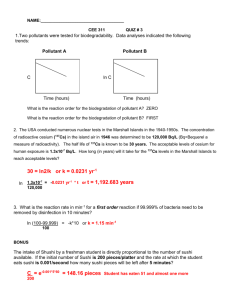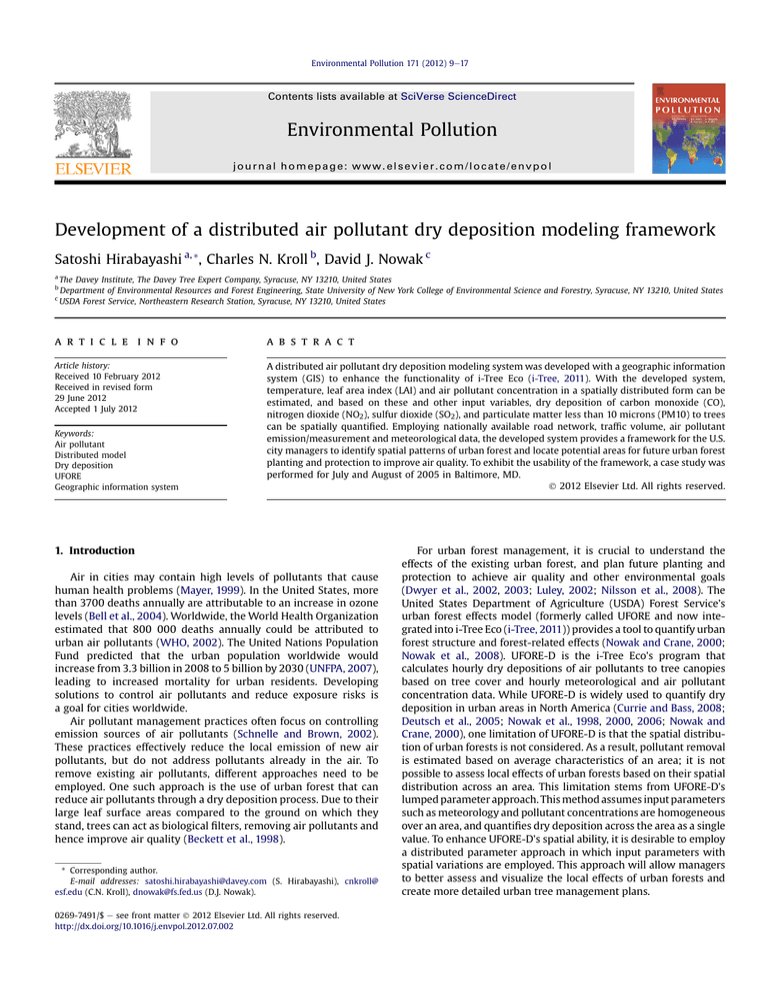
Environmental Pollution 171 (2012) 9e17
Contents lists available at SciVerse ScienceDirect
Environmental Pollution
journal homepage: www.elsevier.com/locate/envpol
Development of a distributed air pollutant dry deposition modeling framework
Satoshi Hirabayashi a, *, Charles N. Kroll b, David J. Nowak c
a
The Davey Institute, The Davey Tree Expert Company, Syracuse, NY 13210, United States
Department of Environmental Resources and Forest Engineering, State University of New York College of Environmental Science and Forestry, Syracuse, NY 13210, United States
c
USDA Forest Service, Northeastern Research Station, Syracuse, NY 13210, United States
b
a r t i c l e i n f o
a b s t r a c t
Article history:
Received 10 February 2012
Received in revised form
29 June 2012
Accepted 1 July 2012
A distributed air pollutant dry deposition modeling system was developed with a geographic information
system (GIS) to enhance the functionality of i-Tree Eco (i-Tree, 2011). With the developed system,
temperature, leaf area index (LAI) and air pollutant concentration in a spatially distributed form can be
estimated, and based on these and other input variables, dry deposition of carbon monoxide (CO),
nitrogen dioxide (NO2), sulfur dioxide (SO2), and particulate matter less than 10 microns (PM10) to trees
can be spatially quantified. Employing nationally available road network, traffic volume, air pollutant
emission/measurement and meteorological data, the developed system provides a framework for the U.S.
city managers to identify spatial patterns of urban forest and locate potential areas for future urban forest
planting and protection to improve air quality. To exhibit the usability of the framework, a case study was
performed for July and August of 2005 in Baltimore, MD.
Ó 2012 Elsevier Ltd. All rights reserved.
Keywords:
Air pollutant
Distributed model
Dry deposition
UFORE
Geographic information system
1. Introduction
Air in cities may contain high levels of pollutants that cause
human health problems (Mayer, 1999). In the United States, more
than 3700 deaths annually are attributable to an increase in ozone
levels (Bell et al., 2004). Worldwide, the World Health Organization
estimated that 800 000 deaths annually could be attributed to
urban air pollutants (WHO, 2002). The United Nations Population
Fund predicted that the urban population worldwide would
increase from 3.3 billion in 2008 to 5 billion by 2030 (UNFPA, 2007),
leading to increased mortality for urban residents. Developing
solutions to control air pollutants and reduce exposure risks is
a goal for cities worldwide.
Air pollutant management practices often focus on controlling
emission sources of air pollutants (Schnelle and Brown, 2002).
These practices effectively reduce the local emission of new air
pollutants, but do not address pollutants already in the air. To
remove existing air pollutants, different approaches need to be
employed. One such approach is the use of urban forest that can
reduce air pollutants through a dry deposition process. Due to their
large leaf surface areas compared to the ground on which they
stand, trees can act as biological filters, removing air pollutants and
hence improve air quality (Beckett et al., 1998).
* Corresponding author.
E-mail addresses: satoshi.hirabayashi@davey.com (S. Hirabayashi), cnkroll@
esf.edu (C.N. Kroll), dnowak@fs.fed.us (D.J. Nowak).
0269-7491/$ e see front matter Ó 2012 Elsevier Ltd. All rights reserved.
http://dx.doi.org/10.1016/j.envpol.2012.07.002
For urban forest management, it is crucial to understand the
effects of the existing urban forest, and plan future planting and
protection to achieve air quality and other environmental goals
(Dwyer et al., 2002, 2003; Luley, 2002; Nilsson et al., 2008). The
United States Department of Agriculture (USDA) Forest Service’s
urban forest effects model (formerly called UFORE and now integrated into i-Tree Eco (i-Tree, 2011)) provides a tool to quantify urban
forest structure and forest-related effects (Nowak and Crane, 2000;
Nowak et al., 2008). UFORE-D is the i-Tree Eco’s program that
calculates hourly dry depositions of air pollutants to tree canopies
based on tree cover and hourly meteorological and air pollutant
concentration data. While UFORE-D is widely used to quantify dry
deposition in urban areas in North America (Currie and Bass, 2008;
Deutsch et al., 2005; Nowak et al., 1998, 2000, 2006; Nowak and
Crane, 2000), one limitation of UFORE-D is that the spatial distribution of urban forests is not considered. As a result, pollutant removal
is estimated based on average characteristics of an area; it is not
possible to assess local effects of urban forests based on their spatial
distribution across an area. This limitation stems from UFORE-D’s
lumped parameter approach. This method assumes input parameters
such as meteorology and pollutant concentrations are homogeneous
over an area, and quantifies dry deposition across the area as a single
value. To enhance UFORE-D’s spatial ability, it is desirable to employ
a distributed parameter approach in which input parameters with
spatial variations are employed. This approach will allow managers
to better assess and visualize the local effects of urban forests and
create more detailed urban tree management plans.
10
S. Hirabayashi et al. / Environmental Pollution 171 (2012) 9e17
Ideally in distributed models all input parameters are available
in a distributed form; however, data limitations often exist due to
lack or incompleteness of measurements (Mulligan and
Wainwright, 2004). As a result, most distributed models use
some of their input parameters in a lumped form. This limitation
exists for UFORE-D when implemented in a distributed approach.
Hirabayashi et al. (2011) performed Monte Carlo with Latin
hypercube sampling and Morris one-at-a-time sensitivity analyses
to determine the input parameters that had the greatest impact on
UFORE-D outputs. They identified temperature and leaf area index
(LAI) as the most sensitive model input parameters. In addition, the
amount of pollutant removed is directly dependent upon ambient
pollutant concentrations. In this study, these three input parameters are distributed and employed with other lumped input
parameters over the study area.
Implementing UFORE-D with a distributed approach requires
dividing a study region into grid cells, applying UFORE-D within
each cell, and composing a distributed result. This analysis can be
streamlined by coupling UFORE-D with a geographical information
system (GIS). In these circumstances, a strategy called tight
coupling is often employed (Fedra, 1996). With tight coupling of
a model and GIS, model functionalities are typically built within
a GIS framework. Thus two originally independent systems are
integrated into one system that provides a common user interface
and a transparent data sharing and transfer between the model and
GIS. Moreover, with functionalities offered by GIS it is possible to
visualize urban forest effects on a municipal map and identify high
risk areas that are potential locations for future urban forest
planting and protection.
The objective of this study is to develop a distributed air
pollutant dry deposition modeling framework by integrating
UFORE-D into a GIS. Employing nationally available data, it provides
urban forest managers in U.S. cities a framework to quantify and
visualize urban forest effects for appropriate management and
design plan developments. Three important input parameters for
UFORE-D (i.e. temperature, LAI, and air pollutant concentration) are
employed in a distributed form. Models to estimate these parameters are also integrated into the system. The model is capable of
estimating concentrations and dry depositions of four criteria air
pollutants (CAPs): carbon monoxide (CO), nitrogen dioxide (NO2),
sulfur dioxide (SO2), and particulate matter less than 10 microns
(PM10). Using this framework, a case study in Baltimore, MD is
performed, in which dry deposition of NO2 for July and August in
2005 are spatially quantified, and future potential urban forest
planting and protecting locations are visually identified.
2. Material and methods
2.1. Temperature calculation
Heisler et al. (2006, 2007) developed empirical models of air temperature
differences between multiple weather stations in the city of Baltimore, MD and
surrounding neighborhoods. On an hourly basis, Turner atmospheric stability
classes are derived from the wind speed and cloud cover (Panofsky and Dutton,
1984), by which hourly meteorological data are stratified. With these explanatory
variables as well as raster datasets representing elevation and upwind cover types
(i.e. forest, impervious and water) from the National Land Cover Dataset (NLCD)
2001 (Homer et al., 2004), temperature differences between a reference site and grid
cells in an area are estimated by regression analysis. Output variables are hourly air
temperature ( C) for each cell.
Landcover types employed are developed open space, developed low intensity,
developed medium intensity, developed high intensity, barren/agricultural land, and
forest/wetland. LAI per unit tree cover for landcover i can be calculated as:
LAIi ¼
LAi
Ai TCi
(1)
2
2
where LAi, Ai, and TCi are leaf area (km ), ground area (km ), and tree coverage (%)
for landcover i, respectively.
2.3. Air pollutant concentration calculation
Air pollutant concentration is calculated based on the methods described in
Morani et al. (2011). Air pollutant concentrations are modeled for two emission
sources: facility stacks (point sources) and traffic on roads (line sources), and
merged into one map and adjusted with monitored data in the area. This method is
not designed to estimate actual air pollutant concentrations, rater the potential
variabilities in concentration due to these emission sources.
Four national databases are employed to calculate air pollutant maps. The
Topologically Integrated Geographic Encoding and Referencing (TIGER) road
network data (TIGER, 2008), the U.S. Department of Transportation’s highway
statistics data (U.S. DOT, 2008), hourly meteorological measurements in 2005 obtained from National Climate Data Center (NCDC) (NCDC, 2008) and the US EPA’s
Nation Emission Inventory (NEI) for 2002 (NEI, 2008).
Air pollutant dispersions from roads are estimated in two steps. First air
pollutant emissions from automobiles are estimated based on traffic volume and
emission factors (Table 1), and then air pollutant dispersion is estimated with
a modified General Finite Line Source Model (GFLSM) (Luhar and Patil, 1989;
McHugh and Thomson, 2003):
Ci ¼
!
"
#
Q
1 zr zs 2
yr þ Li =2
yr Li =2
pffiffiffiffiffiffiiffi
pffiffiffi
pffiffiffi
exp erf
erf
sz
2
2s y
2s z
2 2psz u
(2)
where Ci (g m3) is the air pollutant concentration for road type i, Qi (g s1 m1) is
the pollutant emission rate per unit length for road type i, u (m s1) is wind speed,
sy (m) and sz (m) are the standard deviations of lateral and vertical concentration
distributions, respectively, yr (m) is the crosswind distance between receptor and
source, Li (m) represents in-cell road length for road type i, and zs (¼0.5 m) and zr
(¼1.5 m) are height of the source and receptor, respectively. u must be larger than
0 m s1 to estimate concentrations with Equation (2).
Emission of nitrogen in both highway statistics and NEI data are reported as
oxides of nitrogen (NOx). Air quality standards are expressed in terms of nitrogen
dioxide (NO2) because it is closely related to health effects. The concentration of NOx
estimated with the aforementioned models is converted to the concentration of NO2
based on the empirical function for the ratio of NO2 and NOx (Derwent and
Middleton, 1996).
Pollutants emitted from a point source can be approximated with the Gaussian
dispersion equation expressed as (Zannetti, 1990):
Ci ¼
Q
1 yr 2
1 hs þ Dh zr 2
exp exp sz
2psy sz u
2 sy
2
(3)
where C (g m3) is air pollutant concentration at a receptor, Q (g s1) is pollutant
emission rate from a source facility, Dh (m) is emission plume rise, and hs (m) is
height of the source (stack height).
Several assumptions are made to employ Equations (2) and (3) for estimating air
pollutant concentrations (Turner, 1994). Highway and facility emission data are
provided on an annual basis. These data are converted to per-second values to be
incorporated in Equations (2) and (3) and assumed to be continuous over time. The
mass of emitted pollutants is assumed to remain the same in the atmosphere during
transport, and no pollutants are removed through chemical reactions, gravitational
settling, or turbulent impaction. The meteorological conditions are assumed to
remain unchanged over the time period that the emitted pollutant travels from the
source to receptors. It is assumed that the time averaged concentration profiles at
any distance in both the crosswind and vertical directions are well represented by
Table 1
Emission factors obtained from U.S. Environmental Protection Agency (US EPA,
1998) for CO and NOx, and from EPA’s highway vehicle particulate emission
modeling software, PART5 (US EPA, 2009a) for PM10 and SO2.
2.2. LAI calculation
Road type
LAI is defined as one-sided leaf area of canopy divided by ground projected area
of canopy. From field sampled data gathered in Baltimore in 2004, the maximum
mid-season LAI can be estimated with UFORE-A, a sibling computer program of
UFORE-D integrated in i-Tree Eco. With UFORE-A, leaf area of individual trees is
estimated using regression equations for urban trees (Nowak, 1996), and the leaf
area and tree cover percentage within six NLCD 2001 landcover types are estimated.
Interstate highway (A1)
Other freeway and expressway (A2)
Other principal arterial (A3)
Local road (A4)
Emission factor (g miles1)
CO
NOx
PM10
SO2
7.40
10.58
10.58
20.52
2.58
2.02
2.02
2.02
0.096
0.096
0.096
0.095
0.113
0.113
0.113
0.113
S. Hirabayashi et al. / Environmental Pollution 171 (2012) 9e17
a Gaussian distribution. In addition, ambient background concentration from other
areas and previous hours are not considered. Other potential sources such as homes
and vegetation were also not considered. Because of these assumptions, this method
aims to estimate air pollutant concentrations in a relative sense (e.g. to identify
hotspots).
Since UFORE-D is ultimately intended to assess effects of air quality on human’s
health, a receptor height (zr) of 1.5 m, which is the reported human air aspiration
nas and Banaityte,
_ 2007), is used. It can be assumed that the vertical
height (Vaitieku
profile of the air pollutant concentration is relatively uniform in the daytime when
the atmosphere is unstable and thus is well mixed within the atmospheric boundary
layer (Colbeck and Harrison, 1985; Dop et al., 1977; Hov, 1983). Therefore, our model
limits its analysis to periods with an unstable atmosphere to ensure that the estimated concentration at 1.5 m may be comparable to that at the canopy height of
urban forests. sy and sz in Equations (2) and (3) are empirically calculated based on
atmospheric stability (Green et al., 1980). Emission plume rise, Dh, can be calculated
from the buoyancy flux of emitted gas (Briggs, 1969, 1971, 1974).
For a given hour, hourly air pollutant concentration maps separately created for
facility stacks and the four road types are merged into one map by taking the
summation of values in each cell. The estimated concentrations are averaged for
multiple hours and a concentration adjustment is performed with measured data
averaged for the same time period. Air pollution concentration data employed were
measured in 2005, and obtained from the U.S. Environmental Protection Agency
(EPA)’s Air Quality System (AQS) (US EPA, 2009b). If multiple monitoring sites exist
in an urban area of interest, the area is divided into Thiessen (Voronoi) polygons that
define individual areas of influence around each monitoring site. Thiessen polygons
are mathematically defined by the perpendicular bisectors of lines between all
points (DeMers, 2000). Within each Thiessen polygon, the average difference
between the measured concentration and the estimated concentration of the cell on
which the monitoring site resides is considered the background concentration:
Cb ¼ Cm Ci;j
(4)
3
3
3
where Cb (g m ), Cm (g m ), and Ci,j (g m ) represents average air pollutant
background concentration, average measured air pollutant concentration, and
average estimated air pollutant concentration at cell (i, j) where the monitoring site
resides, respectively. Cb is attributable to unidentified or natural emission sources,
resuspension of past emissions, and long-range transport (US EPA, 2012). Cb may be
negative in cases where the air pollutant emitted within a city is transported by
winds across the city boundary. Values of all Thiessen polygon cells are then
adjusted with this background concentration:
AdjCi;j ¼ Cb þ Ci;j
(5)
where AdjCi,j (g m3) represents the adjusted air pollutant concentration at cell (i, j).
11
8000 s m1 for SO2 to account for the typical variation in rt exhibited among the
pollutants (Lovett, 1994; Taylor et al., 1988). rsoil was set to 2000 s m1 (Meyers and
Baldocchi, 1993). Using a canopy radiative transfer model and a radiation interception model in which the canopy is divided into N layers, rs is calculated based
upon photosynthetic active radiation (PAR) on sunlit and shaded leaves and LAI for
each layer (Baldocchi, 1994; Baldocchi et al., 1987; Farquhar et al., 1980; Harley
et al., 1992; Hirabayashi et al., 2011; Norman, 1980; Norman, 1982; Weiss and
Norman, 1985). All of these values are consistent with those employed by
Hirabayashi et al. (2011).
As removals of CO and PM10 by vegetation are not directly related to transpiration, Rc for CO was set to a constant for the in-leaf season (50 000 s m1) and the
out-of-leaf season (1 000 000 s m1) based on data from Bidwell and Fraser (1972).
For PM10, the median deposition velocity (Lovett, 1994) was set to 0.0064 m s1
based on a 50-percent resuspension rate of particles back to the atmosphere (Zinke,
1967). The base Vd was adjusted according to actual LAI and a surface-area index for
bark of 1.7 (m2 of bark per m2 of ground surface covered by the tree crown)
(Whittaker and Woodwell, 1967).
3. Results and discussion
To demonstrate the functionality of the developed modeling
framework, temperature, LAI, concentration and dry deposition of
NO2 were estimated for Baltimore, MD. The period from July 1st to
August 31st in 2005 was chosen for the analyses because dry
depositions to trees are higher in the in-leaf season (i.e. March
21steOctober 20th for Baltimore in 2005) due to active photosynthesis. Our model limits its analytical conditions to hours with
very unstable atmospheric conditions (Turner Class 1) and noprecipitation to satisfy model assumptions of a fully mixed
boundary layer and to limit to condition of dry deposition. Records
not meeting these conditions were eliminated from the further
analyses, resulting in 160 hourly records.
3.1. Temperature calculation
Temperature raster grids were created for the 160 h (Fig. 1 (a))
Temperature generally exhibited an urban heat island effect, in
which the temperature was highest in the downtown Baltimore
area and gradually decreased towards suburban areas.
2.4. Air pollutant dry deposition calculation
Air pollutant dry deposition is calculated based on the methods described in
Hirabayashi et al. (2011). The distributed version of UFORE-D estimates dry deposition of air pollutants to trees on an hourly basis using distributed temperature,
pollutant concentration, LAI, and other lumped meteorological parameters. UFORED estimates pollutant flux, F (g m2 s1), as a product of the dry deposition velocity,
Vd (m s1), and the air pollutant concentration, C (g m3):
F ¼ Vd $C
(6)
Dry deposition velocity can be estimated as the inverse of the sum of resistances
to pollutant transport (Baldocchi et al., 1987):
Vd ¼ ðRa þ Rb þ Rc Þ1
The maximum mid-season LAI for the six landcover types were
estimated based on UFORE-A outputs (Table 2). Smaller LAI values
were observed in the downtown Baltimore area, where the
developed high intensity and barren/agricultural landcover types
are dominant (Fig. 1(b)). Square shaped patches with high LAI
found in downtown corresponded to a developed open space
landcover type. Suburban areas tended to have larger LAIs due to
forest/wetland and developed open space landcover types.
(7)
where Ra represents air movement resistance in the crown space (aerodynamic
resistance), Rb represents transfer resistance through the boundary layer immediately adjacent to canopy surfaces (quasi-laminar boundary layer resistance), and Rc
represents the chemical and biological absorption capacity of the canopy surfaces
(canopy resistance). Estimates of Ra and Rb are calculated using standard resistance
formulas (Dyer and Bradley, 1982; Killus et al., 1984; Pederson et al., 1995; US EPA,
1995; van Ulden and Holtslag, 1985; Venkatram, 1980) with meteorological data.
Canopy resistance values for NO2 and SO2 are calculated based on a modified hybrid
of the big-leaf and multilayer canopy deposition models (Baldocchi, 1988; Baldocchi
et al., 1987). Canopy resistance has four components: stomatal resistance (rs),
mesophyll resistance (rm), cuticular resistance (rt), and soil resistance (rsoil):
1
1
1
1
¼
þ þ
Rc
rs þ rm rt rsoil
3.2. LAI calculation
(8)
rm was set to 0 s m1 for SO2 (Wesely, 1989), and 100 s m1 for NO2 (Hosker and
Lindberg, 1982) to account for the difference between water vapor and NO2
transport within mesophyll air spaces, and to ensure the Vd calculated was in the
typical range reported by Lovett (1994). rt was set to 20 000 s m1 for NO2 based
upon Wesely (1989) assuming mixed forest in midsummer, and calculated as
3.3. Air pollutant concentration calculation
Radiated highways (A1, A2, and A3) run from downtown to
suburban areas, while a complex system of local roads (A4) exists in
both downtown and suburban areas (Fig. 1(c)). NO2 dispersions
from each of the four road types for the 160 h were estimated. As
buildings in the urban area may alter the dispersion of pollutants
from motor vehicles, the dispersion buffer was limited to 30 m.
NO2 dispersions from facilities were also estimated for the
160 h. The study area contains 368 facility stacks such as chemical,
construction materials, food, wood, heavy industry manufacturing
and utility and medical services. A dispersion buffer of 4000 m was
chosen since the concentrations became almost 0 within this
distance for all sources. Raster grids representing the hourly
distribution of NO2 concentrations from road traffic and facility
emissions were merged.
12
S. Hirabayashi et al. / Environmental Pollution 171 (2012) 9e17
Fig. 1. (a) Temperature estimated for July 1st, 2005 at 9:00 AM, (b) LAI, (c) road networks, (d) facility locations with annual NOx emission rates and NO2 concentrations averaged for
160 h analysis period.
A raster representing the average NO2 concentration over the
160 rasters was created, resulting in concentrations ranged from
0.04 to 73.4 mg m3across the study area. There is only one NO2
monitoring site in Baltimore, and the average estimated concentration at the cell where the monitoring site exists was 2.0 mg m3,
while the average measured value over the same period was
26.3 mg m3. Based on this difference, all cells in Baltimore were
adjusted with Equations (4) and (5), resulting in the NO2 concentrations ranging from 24.3 to 97.7 mg m3 (Fig. 1(d)).
Since a major source of NO2 is automobiles, high NO2 concentrations were found along highways, while local traffic contributed
less to the concentrations. High NO2 concentrations radiating from
Table 2
LAI, mean Vd and range of F for NO2 (calculated across 160 rasters) for six landcover
types.
Landcover type
LAI
Mean of
Vd (cm s1)
Range of F
(mg m2 h1)
Developed high intensity
Developed medium intensity
Barren/agricultural land
Developed low intensity
Forest/wetland
Developed open space
2.89
3.68
3.90
4.28
4.85
6.37
0.41
0.49
0.51
0.55
0.60
0.72
0.35e0.97
0.42e1.57
0.44e1.60
0.47e1.62
0.51e1.42
0.61e2.26
S. Hirabayashi et al. / Environmental Pollution 171 (2012) 9e17
some facility stacks were also observed. These facilities emit more
than 100 tons of NOx annually. This NO2 dispersion pattern is
consistent with wind direction and speed in the analysis period
(Fig. 2). Winds were mainly from the West and Northwest, and
these winds drove NO2 dispersion to the east of facilities.
In our model, air pollutant concentration is estimated based on
air pollutant emission and dispersion. Major factors affecting
emission and dispersion are anthropogenic factors (transportation
volume and industrial activities) and meteorological factors (wind
and atmospheric stability), respectively. Interactions between these
and other factors such as plant activities create different seasonal
and diurnal variations in CO, NO2, PM10 and SO2 concentrations
(Atkins and Lee, 1995; Chen et al., 2001; Hargreaves et al., 2000;
Nowak et al., 2006; US EPA, 2010). In addition, depending on study
area’s geographical factors such as terrain (surface roughness) and
wind directions relative to emission sources and measuring points,
trends in air pollutant concentrations may greatly vary (Zoras et al.,
2006).
Our model is only capable of estimating air pollutant dispersion
when the atmosphere is very unstable in daytime. Under such
conditions, CO and NO2 concentrations may generally be lower due
to well mixed and diluted air (Ashrafi and Hoshyaripour, 2010;
Garnett, 1979; Katsoulis, 1996). Measured CO and NO2 concentrations exhibited this general trend (Table 3). Because of the model
limitation, NO2 dispersion estimates in Fig. 2 did not capture the
worst air quality conditions. The same restriction applies to CO
dispersion estimates. For SO2, though, the concentrations were
higher under unstable conditions, and PM10 concentrations
showed no distinct difference due to atmospheric conditions
(Table 3). The developed model therefore may capture periods with
the worst air quality for SO2 and PM10.
The US EPA has set national ambient air quality standards
(NAAQS) for CAPs considered harmful to public health and the
environment (US EPA, 2009c). The NAAQS level of NO2 is defined as
100 mg m3 yr1. Areas where air pollution levels persistently
exceed the NAAQS are designated as nonattainment areas by the US
EPA. Since Baltimore is not designated as nonattainment, the estimated concentrations shouldn’t exceed the standard levels. Estimated hourly NO2 concentration ranged from 24.3 to 97.7 mg m3
13
Table 3
Average concentrations measured in July and August, 2005 in Baltimore, MD.
Stability classes were determined based on cloud cover, ceiling height, solar elevation and wind speed (US EPA, 1995). Stability classes from 1 to 3 occur in daytime,
while 5 to 7 occur in nighttime. Stability class 4 occurs both in daytime and
nighttime.
Stability class
Average concentration (mg m3)
CO
NO2
PM10
SO2
1
2
3
4
5
6
7
297.1
307.4
337.8
383.0
380.1
397.2
381.2
27.0
30.4
33.1
35.1
40.2
42.2
47.1
32.6
33.1
33.8
33.4
33.6
33.4
33.3
23.6
20.5
17.0
13.5
8.7
8.2
8.3
(very unstable)
(unstable)
(slightly unstable)
(neutral)
(slightly stable)
(stable)
(very stable)
for the period of July and August 2005, and thus maximum estimated concentrations for this period were estimated to be below
the yearly NO2 standard.
3.4. Air pollutant dry deposition calculation
Both Ra and Rb exhibited very slight variations caused by
temperature, in which larger resistances generally correspond to
lower temperature (Fig. 3 (a)). Rc, Vd, and F generally reflected the
same spatial pattern as LAI (Fig. 3(b), (c) and (d)). Since air pollutant
transportation could be enhanced with larger leaf areas, cells with
larger LAI resulted in smaller Rc and thus larger Vd and F. For the
averaged Vd and F rasters, mean of Vd and range of F for cells with
a given LAI value were calculated (Table 2). As shown, both Vd and F
are dependent upon LAI values.
To access future urban forest planting and protection needs,
areas where Vd was small despite high concentrations were visually
identified. Vd and concentration raster grids averaged over 160 h
were employed in this analysis. For each raster, percentiles of cell
values were calculated and areas with a small percentile of Vd and
a large percentile of concentration were determined (Fig. 4). Hotspots are found along highways and areas surrounding NO2 emitting facilities. It should be noted that these hotspots are only
representative for relatively low NO2 concentrations estimated
during very unstable hours by our dispersion model. Although they
represent the potential future planting and protecting areas, additional areas may be identified when our dispersion model is
upgraded to address atmospheric stabilities other than very
unstable conditions. It is expected the air quality in Baltimore can
be improved by planting more trees in these areas, though future
planting possibilities may be limited because these areas correspond to developed medium and high intensity landcover types. It
may not be easy to plant trees in these impervious areas; however,
as an alternative, the feasibility of green roofs has been studied in
urban areas (Currie and Bass, 2008; Deutsch et al., 2005; Yang et al.,
2008). This approach may be adopted in Baltimore.
3.5. Uncertainties and limitations of the modeling system
Fig. 2. Frequency of occurrence of wind speed and direction over the 160 h in July and
August, 2005 in Baltimore.
While the developed modeling framework provides urban
forest managers a very useful tool to quantify and visualize urban
forest effects, the analysis in Baltimore should be treated as an
approximation rather than an accurate estimation of actual
processes. Several uncertainties should be noted, which are
a combination of uncertainties in input variables, choice of model,
and model parameterization.
The temperature regression model employed was developed
using more than 3000 h of meteorological data from seven weather
stations and more than 130 potential explanatory variables in
14
S. Hirabayashi et al. / Environmental Pollution 171 (2012) 9e17
Fig. 3. (a) Ra and (b) Rc estimated for July 1st, 2005 at 9:00 AM, (c) Vd and (d) F estimated for NO2 averaged over 160 h analysis period.
Baltimore. Nonetheless, the coefficient of determination (R2) was
fairly low, ranging from 0.27 to 0.49 (Heisler et al., 2007). The model
could be improved with data from a greater number of weather
stations, higher resolution land cover data, and incorporation of
a vertical-dimension analysis (Heisler et al., 2007).
Estimating pollutant concentrations at the local scale is technically difficult because it requires knowledge of spatial and
temporal variability of pollutant concentrations at a small scale
(Jerrett et al., 2007). Methods for estimating spatial patterns of
pollution concentration include interpolation of concentration
taken from existing monitoring networks (Wong et al., 2004),
statistical regressions of observed concentrations with surrounding
land use, traffic characteristics (Brauer et al., 2003; Briggs et al.,
1997; Ollinger et al., 1993; Ross et al., 2006) and meteorological
processes (Ainslie et al., 2008; Jerrett et al., 2007). However, due to
the insufficient density of the monitoring network, small scale
concentration variability cannot be resolved with these methods. In
this study, therefore, dispersion modeling techniques were
employed. One major drawback of this technique is its reliance on
detailed spatial and temporal emissions inventories that are known
to have large uncertainties (Hanna et al., 2001). In this study, the
temporal resolutions of the road and facility emission data
employed were originally annual and downscaled to per-second
values to be incorporated in the dispersion equations (Equations
(2) and (3)). Since weekly or diurnal variations of emissions due to
driving and facility operational patterns were not taken into
S. Hirabayashi et al. / Environmental Pollution 171 (2012) 9e17
15
operational in the United States, such as the Clean Air Status and
Trends Network (CASTNet) (Clarke et al., 1997) and the Atmospheric
Integrated Research Monitoring Network (AIRMoN) (Hicks et al.,
2001) are estimating dry depositions based on an inferential
method similar to those implemented in UFORE-D with local meteorological data. In addition, all of these sites are located in rural areas
to avoid inputs from local pollutant sources. The Air Resource Laboratory (ARL) team at National Oceanic and Atmospheric Administration (NOAA) has developed a movable system for direct measurement
of dry deposition fluxes (ARL, 2008). When these systems become
more common in the future, calibration and validation exercises of
modeled dry deposition processes will be improved.
4. Conclusions
In this study a distributed air pollutant dry deposition modeling
framework coupled with a GIS was developed. With the developed
system, distributed temperature, LAI, NO2 concentration and dry
deposition were estimated for Baltimore, MD. Based on the model
development and case study, the following conclusions were
reached:
Fig. 4. NOx emission rate and potential planting and protection areas. Cells smaller
than the 30th percentile of Vd (0.49 cm s1) and larger than the 90th percentile of
concentration (25.6 mg m3) are highlighted.
consideration in the downscaling process, the air pollutant
concentrations may have large uncertainties, with times of larger
emissions overlooked. In addition, street canyon effects (Wang
et al., 2008) were ignored and background concentrations (Jensen
et al., 2001) were not fully addressed in the model, thus air
pollutant concentrations were generally underestimated.
The developed modeling framework has several limiting
analytical conditions. Wind and atmospheric stability are the
primary factors impacting the dispersion model. Wind speed must
be larger than 0 to utilize dispersion equations. To assess the
concentrations when there is no wind, a windless model (Jin and
Fu, 2005) needs to be added to the framework. To assume the
concentrations estimated with the dispersion models are vertically
representative in the air, only hours with a very unstable atmosphere are processed. As unstable conditions commonly develop on
sunny days with low wind speed (US EPA, 1995), the influences of
variations in wind speed may be minimal. On the other hand, wind
direction may vary within the temporal resolution of the system
(1 h) when the atmosphere is very unstable. This variation in wind
direction may affect the dispersion estimates. In our analysis, we
took average of 160 h of dispersion estimates to balance out these
random effects of wind direction. To handle other atmospheric
conditions, vertical profiles of the concentrations need to be
accounted for in the system. Due to difficulties in estimating all
UFORE-D input parameters in a distributed form, the spatial
distributions of only three parameters were estimated in this study.
More parameters in a distributed form may lead to model
improvements. Such parameters include relative humidity that was
found to have a linear influence on dry depositions, and PAR and
wind speed that were influential up to its threshold (Hirabayashi
et al., 2011). Jerrett et al. (2007) estimated wind fields with an
interpolation technique.
Measured regional dry deposition estimates are not available in
Baltimore to validate the modeled results and confirm their uncertainties. Dry deposition measurement networks currently
1. Estimation of the dry deposition processes and its input
parameters in a distributed form can be performed within one
integrated system that can aid in urban forest management and
planning.
2. As the developed framework is based on nationally available
input data in the United States, the method is transferable to
any U.S. city.
3. Future planting and protection spots can be visually identified
at cells with a combination of small Vd and large concentration.
While a number of simplifying assumptions were made to
develop the system, the modeling framework presented provides
a prototype to aid forest managers to determine the most appropriate area to plant and protect trees to help improve air quality.
Future analyses will explore the tradeoffs between model
complexity and ease of use, and many of the assumptions made in
this paper will be evaluated. The ultimate goal is to develop a model
which can be employed by urban planners and managers with
limited computational requirements. A system based on this
development will evolve into a new i-Tree tool called i-Tree
Landscape.
References
Ainslie, B., Steyn, G.G., Su, J., Buzzelli, M., Brauer, M., Larson, T., Rucker, M., 2008.
A source area model incorporating simplified atmospheric dispersion and
advection at fine scale for population air pollutant exposure assessment.
Atmospheric Environment 42, 2394e2404.
Air Resources Laboratory (ARL), 2008. AIRMoN Dry Deposition. From: http://www.
arl.noaa.gov/research/projects/airmon_dry.html (accessed September, 2008).
Ashrafi, Kh., Hoshyaripour, Gh., A., 2010. A model to determine atmospheric
stability and its correlation with CO concentration. International Journal of Civil
and Environmental Engineering 2, 83e88.
Atkins, D.H.F., Lee, D.S., 1995. Spatial and temporal variation of rural nitrogen
dioxide concentrations across the United Kingdom. Atmospheric Environment
29, 223e239.
Baldocchi, D.D., Hicks, B.B., Camara, P., 1987. A canopy stomatal resistance model for
gaseous deposition to vegetated surfaces. Atmospheric Environment 21, 91e101.
Baldocchi, D., 1988. A multi-layer model for estimating sulfur dioxide deposition to
a deciduous oak forest canopy. Atmospheric Environment 22, 869e884.
Baldocchi, D., 1994. An analytical solution for coupled leaf photosynthesis and
stomatal conductance models. Tree Physiology 14, 1069e1079.
Beckett, K.P., Freer-Smith, P.H., Taylor, G., 1998. Urban woodlands: their role in
reducing the effects of particulate pollution. Environmental Pollution 99,
347e360.
Bell, M.L., McDermott, A., Zeger, S.L., Samet, J.M., Dominici, F., 2004. Ozone and
short-term mortality in 95 US urban communities, 1987e2000. JAMA 292,
2372e2378.
16
S. Hirabayashi et al. / Environmental Pollution 171 (2012) 9e17
Bidwell, R.G., Fraser, D.E., 1972. Carbon monoxide uptake and metabolism by leaves.
Canadian Journal of Botany 50, 1435e1439.
Brauer, M., Hoek, G., Van Vilet, P., Meliefste, K., Fischer, P., Gehring, U., Heinrich, J.,
Cyrys, J., Bellander, T., Lewne, M., Brunekreef, B., 2003. Estimating long-term
average particulate air pollution concentrations: application of traffic indicators and geographic information systems. Epidemiology 14, 228e239.
Briggs, D.J., Collins, S., Elliott, P., Fixher, P., Kingham, S., Lebret, E., Pryl, K.,
VanReeuwijk, H., Smallbone, K., VanderVeen, A., 1997. Mapping urban air
pollution using GIS: a regression ebased approach. International Journal of
Geographical Information Science 11, 699e718.
Briggs, G.A., 1969. Plume Rise, U.S. Atomic Energy Commission Critical Review
Series T/D 25075.
Briggs, G.A., 1971. Some recent analyses of plume rise observations. In:
Englund, H.M., Berry, W.T. (Eds.), Proc. 2nd Int. Clean Air Congress. Academic
Press, New York.
Briggs, G.A., 1974. Diffusion estimation for small emissions. In: Environmental
Research Laboratories Air Resources Atmospheric Turbulence and Diffusion
Laboratory 1973 Annual Report, USAEC Report ATDL-106. National Oceanic and
Atmospheric Administration, Washington DC.
Chen, L.-W.A., Doddridge, B.G., Dickerson, R.R., Chow, J.C., Mueller, P.K., Quinn, J.,
Butler, W.A., 2001. Seasonal variations in elemental carbon aerosol, carbon
monoxide and sulfur dioxide: Implications for sources. Geophysical Research
Letters 23, 1711e1714.
Clarke, J.F., Edgerton, E.S., Martin, B.E., 1997. Dry deposition calculations for the
clean air status and trends network. Atmospheric Environment 31, 3667e3678.
Colbeck, I., Harrison, R.M., 1985. Dry deposition of ozone: some measurements of
deposition velocity and of vertical profiles to 100 meters. Atmospheric Environment 19, 1807e1818.
Currie, B.A., Bass, B., 2008. Estimates of air pollution mitigation with green plants
and green roofs using the UFORE model. Urban Ecosystems 11, 409e422.
DeMers, M.N., 2000. Fundamentals of Geographic Information Systems, second ed.
John Wiley & Sons, New York.
Derwent, R.G., Middleton, D.R., 1996. An empirical function for the ratio NO2:NOx.
Clean Air 26, 57e60.
Deutsch, B., Whitlow, H., Sullivan, M., Savineau, A., 2005. Re-greening Washington,
DC: a Green Roof Vision Based on Quantifying Storm Water and Air Quality
Benefits. From: http://www.greenroofs.org/resources/greenroofvisionfordc.pdf
(accessed February, 2009).
Dop, H., Van, Guicherit, R., Lanting, R.W., 1977. Some measurements of the vertical
distribution of ozone in the atmospheric boundary layer. Atmospheric Environment 11, 65e71.
Dwyer, J.F., Nowak, D.J., Watson, G.W., 2002. Future directions for urban forestry
research in the United States. Journal of Arboriculture 28, 231e236.
Dwyer, J.F., Nowak, D.J., Noble, M.-H., 2003. Sustaining urban forests. Journal of
Arboriculture 29, 49e55.
Dyer, A.J., Bradley, C.F., 1982. An alternative analysis of flux gradient relationships.
Boundary-Layer Meteorology 22, 3e19.
Farquhar, G.D., von Caemmerer, S., Berry, J.A., 1980. A biochemical model of
photosynthetic CO2 assimilation in leaves of C3 species. Planta 149, 78e90.
Fedra, K., 1996. Distributed models and embedded GIS: integration strategies and
case studies. In: Goodchild, M.F., et al. (Eds.), GIS and Environmental Modeling:
Progress and Research Issues. GIS World Books, Fort Collins, CO, pp. 413e417.
Garnett, A., 1979. Nitrogen oxides and carbon monoxide air pollution in the city of
Sheffield. Atmospheric Environment 13, 845e852.
Green, A.E., Singhal, R.P., Venkateswar, R., 1980. Analytic extensions of the Gaussian
plume model. JAPCA 30, 773e776.
Hanna, S.R., Lu, Z., Frey, H.C., Wheeler, N., Vukovich, J., Arunachalam, S., Fernau, M.,
Hansen, D.A., 2001. Uncertainties in predicted ozone concentrations due to
input uncertainties for the UAM-V photochemical grid model applied to the July
1985 OTAG domain. Atmospheric Environment 35, 891e903.
Hargreaves, P.R., Leidi, A., Grubb, H.J., Howe, M.T., Mugglestone, M.A., 2000. Local
and seasonal variations in atmospheric nitrogen dioxide levels at Rothamsted,
UK, and relationships with meteorological conditions. Atmospheric Environment 34, 843e853.
Harley, P.C., Thomas, R.B., Reynolds, J.F., Strain, B.R., 1992. Modelling photosynthesis
of cotton grown in elevated CO2. Plant, Cell and Environment 15, 271e282.
Heisler, G., Walton, J., Grimmond, S., Pouyat, R., Belt, K., Nowak, D., Yesilonis, I., Hom,
J., 2006. Land-cover influences on air temperatures in and near Baltimore, MD.
Presented at 6th International Conference on Urban Environment, Gotheburg,
Sweden.
Heisler, G., Walton, J., Yesilonis, I., Nowak, D., Pouyat, R., Grant, R., Grimmond, S.,
Hyde, K., Bacon, G., 2007. Empirical modeling and mapping of below-canopy air
temperatures in Baltimore, MD and vicinity. In: Proceedings of Seventh Urban
Environment Symposium, San Diego, CA.
Hicks, B.B., Meyers, T.P., Hosker Jr., R.P., Artz, R.S., 2001. Climatological features of
regional surface air quality from the atmospheric integrated research monitoring
network (AIRMoN) in the USA. Atmospheric Environment 35, 1053e1068.
Hirabayashi, S., Kroll, C.N., Nowak, D.J., 2011. Component-based development and
sensitivity analyses of an air pollutant dry deposition model. Environmental
Modelling & Software 26, 804e816.
Homer, C., Huang, C., Yang, L., Wylie, B., Coan, M., 2004. Development of a 2001
national landcover database for the United States. Photogrammetric Engineering and Remote Sensing 70, 829e840.
Hosker Jr., R.P., Lindberg, S.E., 1982. Review: atmospheric deposition and plant
assimilation of gases and particles. Atmospheric Environment 16, 889e910.
Hov, Ø., 1983. One-dimensional vertical model for ozone and other gases in the
atmospheric boundary layer. Atmospheric Environment 17, 535e549.
i-Tree, 2011. i-Tree: Tools for Assessing and Managing Community Forests. From:
http://www.itreetools.org/ (accessed July, 2011).
Jensen, S.S., Berkowicz, R., Hansen, H.S., Hertel, O., 2001. A Danish decision-support
GIS tool for management of urban air quality and human exposures. Transportation Research Part D 6, 229e241.
Jerrett, M., Arain, A., Kanaroglou, P., Beckerman, B., Crouse, D., Gilbert, N.L.,
Brook, J.R., Finkelstein, N., Finkelstein, M.M., 2007. Modelling the intra-urban
variability of ambient traffic pollution in Toronto, Canada. Journal of Toxicology and Environment Health, Part A 70, 200e212.
Jin, T., Fu, L., 2005. Application of GIS to modified models of vehicle emission
dispersion. Atmospheric Environment 39, 6326e6333.
Katsoulis, B.D., 1996. The relationship between synoptic, mesoscale and microscale
meteorological parameters during poor air quality events in Athens, Greese. The
Science of the Total Environment 181, 13e24.
Killus, J.P., Meyer, J.P., Durran, D.R., Anderson, G.E., Jerskey, T.N., Reynolds, S.D.,
Ames, J., 1984. Continued Research in Mesoscale Air Pollution Simulation
Modeling. In: Refinements in Numerical Analysis, Transport, Chemistry, and
Pollutant Removal. Publ. EPA/600/3.84/095a, vol. V. U.S. Environmental
Protection Agency, Research Triangle Park, NC.
Lovett, G.M., 1994. Atmospheric deposition of nutrients and pollutants in North
America: an ecological perspective. Ecological Applications 4, 629e650.
Luhar, A.K., Patil, R.S., 1989. A general finite line source model for vehicular pollution prediction. Atmospheric Environment 23, 555e562.
Luley, C.J., 2002. A Plan to Integrate Management of Urban Trees into Air Quality
Planning: a Report to North East State Foresters Association. Davey Resource
Group, New York.
Mayer, H., 1999. Air pollution in cities. Atmospheric Environment 33, 4029e4037.
McHugh, C.A., Thomson, D.J., 2003. Implementation of Area, Volume and Line
Sources. ADMS 3 Techinical Specification. From: http://www.cerc.co.uk/
software/pubs/ADMS techspec.htm (accessed 06.02.09.).
Meyers, T.P., Baldocchi, D.D., 1993. Trace gas exchange above the floor of a deciduous forest 2. SO2 and O3 deposition. Journal of Geophysical Research 98,
12631e12638.
Morani, A., Nowak, D.J., Hirabayashi, S., Calfapietra, C., 2011. How to select the best
tree planting locations to enhance air pollution removal in the MillionTreesNYC
initiative. Environmental Pollution 159, 1040e1047.
Mulligan, M., Wainwright, J., 2004. Modelling and model building. In:
Wainwright, J., Mulligan, M. (Eds.), Environmental Modelling: Finding
Simplicity in Complexity. John Wiley & Sons, Hoboken, NJ, pp. 7e73.
National Climate Data Center (NCDC), 2008. World’s Largest Archive of Climate
Data: National Climate Data Center. From: http://www.ncdc.noaa.gov/oa/ncdc.
html (accessed September, 2008).
National Emissions Inventory (NEI), 2008. Technology Transfer Network Clearinghouse for Inventories & Emissions Factors. From: http://www.epa.gov/ttn/chief/
eiinformation.html (accessed July, 2008).
Nilsson, K., Randrup, T.B., Wandall, B.M., 2008. Trees in the urban environment. In:
Evans, J. (Ed.), The Forests Handbook. An Overview of Forest Science, vol. 1.
Blackwell Science Ltd., UK, pp. 347e361.
Norman, J.M., 1980. Interfacing leaf and canopy light interception models. In:
Hesketh, J.D., Jones, J.W. (Eds.), Predicting Photosynthesis for Ecosystem
Models, vol. II. CRC Press, Boca Raton, FL, pp. 49e67.
Norman, J.M., 1982. Simulation of microclimates. In: Biometeorology in Integrated
Pest Management, Proceedings of a Conference on Biometeorology and Integrated Pest Management, Davis, CA, pp. 65e99.
Nowak, D.J., Crane, D.E., 2000. The Urban Forest Effects (UFORE) Model: quantifying urban forest structure and functions. In: Hansen, M., Burk, T. (Eds.),
Integrated Tools for Natural Resources Inventories in the 21st Century:
Proceedings of the IUFRO Conference, Gen. Tech. Rep. NC-212. U.S. Department of Agriculture, Forest Service, North Central Research Station, St. Paul,
MN, pp. 714e720.
Nowak, D.J., McHale, P.J., Ibarra, M., Crane, D., Stevens, J., Luley, C., 1998. Modeling
the effects of urban vegetation on air pollution. In: Gryning, S.E.,
Chaumerliac, N. (Eds.), Air Pollution Modeling and Its Application XII. Plenum
Press, New York, pp. 399e407.
Nowak, D.J., Civerolo, K.L., Rao, S.T., Sistla, G., Juley, C.J., Crane, D.E., 2000.
A modeling study of the impact of urban trees on ozone. Atmospheric Environment 34, 1601e1613.
Nowak, D.J., Crane, D.E., Stevens, J.C., 2006. Air pollution removal by urban trees and
shrubs in the United States. Urban Forestry & Urban Greening 4, 115e123.
Nowak, D.J., Crane, D.E., Stevens, J.C., Hoehn, R.E., Walton, J.T., Bond, J., 2008.
A ground-based method of assessing urban forest structure and ecosystem
services. Arboriculture & Urban Forestry 34, 347e358.
Nowak, D.J., 1996. Estimating leaf area and leaf biomass of open-grown deciduous
urban trees. Forest Science 42, 504e507.
Ollinger, S.V., Aber, J.D., Lovett, G.M., Millham, S.E., Lathrop, R.G., Ellis, J.M., 1993.
A spatial model of atmospheric deposition for the northeastern U.S. Ecological
Applications 3, 459e472.
Panofsky, H.A., Dutton, J.A., 1984. Atmospheric Turbulence. John Wiley, New York.
Pederson, J.R., Massman, W.J., Mahrt, L., Delany, A., Oncley, S., den Hartog, G.,
Neumann, H.H., Mickle, R.E., Shaw, R.H., Paw, U.K.T., Grantz, D.A.,
MacPherson, J.I., Desjardins, R., Schuepp, P.H., Pearson Jr., R., Arcado, T.E., 1995.
California ozone deposition experiment: methods, results, and opportunities.
Atmospheric Environment 29, 3115e3132.
S. Hirabayashi et al. / Environmental Pollution 171 (2012) 9e17
Ross, Z., English, P.B., Scalf, R., Gunier, R., Smorodinsky, S., Wall, S., Jerrett, M., 2006.
Nitrogen dioxide prediction in Southern California using land use regression
modeling: potential for environmental health analyses. Journal of Exposure
Science and Environmental Epidemiology 16, 106e114.
Schnelle Jr., K.B., Brown, C.A., 2002. Air Pollution Control Technology Handbook.
CRC Press, Boca Raton, FL.
Taylor Jr., G.E., Hanson, P.J., Baldocchi, D.D., 1988. Pollutant deposition to individual
leaves and plant canopies: sites of regulation and relationship to injury. In:
Heck, W.W., Taylor, O.C., Tingey, D.T. (Eds.), Assessment of Crop Loss from Air
Pollutants. Elsevier Applied Science, London, England, pp. 227e258.
Topologically Integrated Geographic Encoding and Referencing (TIGER), 2008.
TIGER, TIGER/Line and TIGER-Related Products. From: http://www.census.gov/
geo/www/tiger/ (accessed 18.12.08.).
Turner, B.D., 1994. Workbook of Atmospheric Dispersion Estimates: an Introduction
to Dispersion Modeling. Lewis Publishers, Boca Raton, FL.
U. S. Environmental Protection Agency (US EPA), 2010. AirData: About the AQS
Database. From: http://www.epa.gov/air/data/aqsdb.html (accessed January,
2010).
U.S. Department of Transportation (DOT), 2008. Highway Statistics Publications. From:
http://www.fhwa.dot.gov/policy/ohpi/hss/hsspubs.cfm (accessed 18.12.08.).
U.S. Environmental Protection Agency (US EPA), 1995. PCRAMMET User’s Guide. U.S.
Environmental Protection Agency, Research Triangle Park, NC.
U.S. Environmental Protection Agency (US EPA), 1998. AP-42, Air Pollutant Emission
Factors, 1998. U.S. Environmental Protection Agency, Office of Mobile Sources.
U.S. Environmental Protection Agency (US EPA), 2009a. Highway Vehicle Particulate
Emission Modeling Software e Part5. From: http://epa.gov/OMS/part5.htm
(accessed February, 2009).
U.S. Environmental Protection Agency (US EPA), 2009b. Technology Transfer
Network (TTN): Air Quality System (AQS). From: http://www.epa.gov/ttn/airs/
airsaqs/ (accessed February, 2009).
U.S. Environmental Protection Agency (US EPA), 2009c. National Ambient Air
Quality Standards (NAAQS). From: http://www.epa.gov/air/criteria.html
(accessed February, 2009).
U.S. Environmental Protection Agency (US EPA), 2012. Technology Transfer
Network: 1999 National-scale Air Toxics Assessment. From: http://www.epa.
gov/ttn/atw/nata1999/background.html (accessed June, 2012).
17
United Nations Population Fund (UNFPA), 2007. State of World Population 2007:
Unleashing the Potential of Urban Growth. From: http://www.unfpa.org/swp/
2007/presskit/pdf/sowp2007_eng.pdf (accessed March, 2009).
nas, P., Banaityte,
_ R., 2007. Modeling of motor transport exhaust pollutant
Vaitieku
dispersion. Journal of Environmental Engineering and Landscape Management
XV, 39e46.
van Ulden, A.P., Holtslag, A.A.M., 1985. Estimation of atmospheric boundary layer
parameters for diffusion application. Journal of Climatology and Applied
Meteorology 24, 1196e1207.
Venkatram, A., 1980. Estimating the MonineObukhov length in the stable boundary
layer for dispersion calculations. Boundary-Layer Meteorology 19, 481e485.
Wang, G., van den Bosch, F.H.M., Kuffer, M., 2008. Modeling urban traffic air
pollution dispersion. The International Archives of the Photogrammetry,
Remote Sensing and Spatial Information Sciences XXXVII (Part B8), 153e158.
Weiss, A., Norman, J.M., 1985. Partitioning solar radiation into direct and diffuse,
visible and near-infrared components. Agricultural and Forest Meteorology 34,
205e213.
Wesely, M.L., 1989. Parameterization of surface resistances to gaseous dry deposition in regional-scale numerical models. Atmospheric Environment 23,
1293e1304.
Whittaker, R.H., Woodwell, G.M., 1967. Surface area relations of woody plants and
forest communities. American Journal of Botany 54, 931e939.
Wong, D.W., Yuan, L., Perlin, S.A., 2004. Comparison of spatial interpolation
methods for the estimation of air quality data. Journal of Exposure Analysis and
Environmental Epidemiology 14, 404e415.
World Health Organization (WHO), 2002. The World Health Report 2002: Reducing
Risks, Promoting Healthy Life. WHO, Geneva.
Yang, J., Yu, Q., Gong, P., 2008. Quantifying air pollution removal by green roofs in
Chicago. Atmospheric Environment 42, 7266e7273.
Zannetti, P., 1990. Air Pollution Modeling: Theories, Computational Methods and
Available Software. Computational Mechanics.
Zinke, P.J., 1967. Forest interception studies in the United States. In: Sopper, W.E.,
Lull, H.W. (Eds.), Forest Hydrology. Pergamon Press, Oxford, UK, pp. 137e161.
Zoras, S., Triantafyllou, A.G., Deligiorgi, D., 2006. Atmospheric stability and PM10
concentrations at far distance from elevated point sources in complex terrain:
worst-case episode study. Journal of Environmental Management 80, 295e302.

